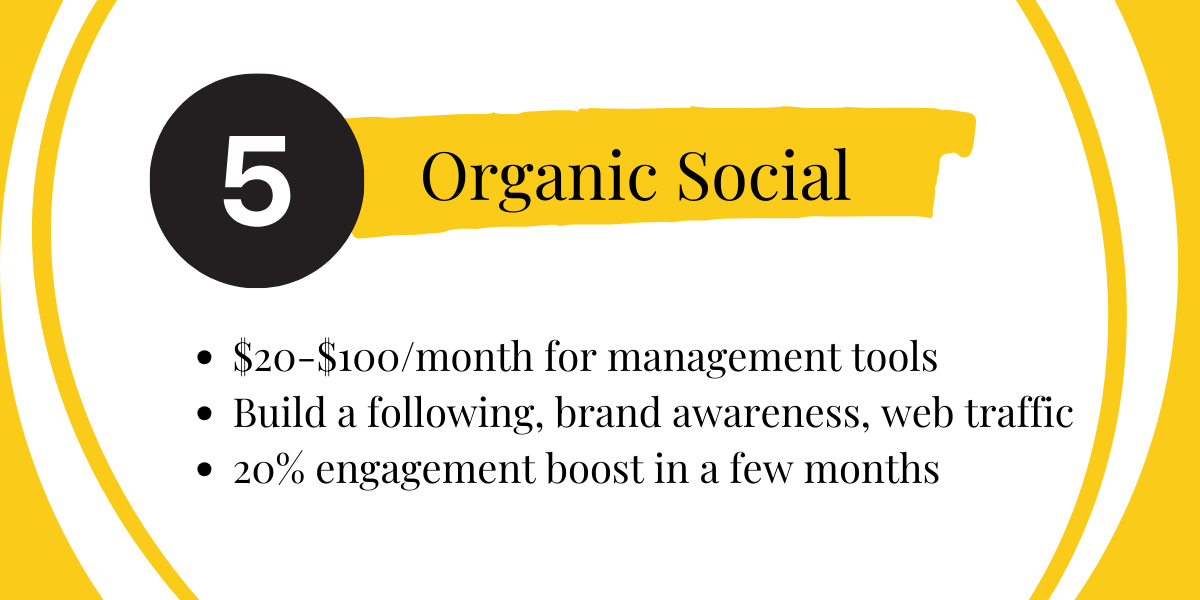How far can $500 a month stretch for marketing? For small businesses, it’s a tough question. Some have even less.
The good news is it can be done — but you have to be strategic. It depends on how competitive your industry is and the reach you want.
With limited funds, deciding where to invest can feel overwhelming.
Based on Zoe Marketing & Communications’ experience, five tactics make sense: Google Ads, Facebook ads, first-party email marketing, local SEO and organic social media.
While $500 won’t cover all five, you can mix and match to start seeing results.
FREE GUIDE
Download Your Digital Ads Guide
Learn how digital ads can help your business, including the tools, techniques and strategies to create successful campaigns.
5 marketing tactics under $500/month
For these examples, we assume DIY marketing, not agency management.
1. Search engine marketing (SEM) ($200+/month)
SEM, often through Google Ads, increases visibility when people search for your business.

- Cost: $1-$2 per click; expect 100-200 clicks/month
- Strategy: Geo-target local searches, A/B test ads, focus on high-intent keywords
- Results: About 3-7 conversions/month (based on a 3.75% conversion rate)
Keep in mind
- $1,000-$3,000 a month is better for effective campaigns but $200 can get you started.
- Competitive industries like law and insurance cost more, with some keywords exceeding $50 per click.
2. Facebook ads ($300+/month)
Social media ads grab attention where people already spend time.

- Cost: About $1 per click; expect 300 clicks/month
- Strategy: Use detailed targeting, create engaging ads, test carousel formats
- Results: Up to 28 conversions/month (Facebook ads have a 9% conversion rate)
Keep in mind
- A lot depends on your message. Keep in mind sales ads drive awareness, but sales can be tricky.
- Targeting correctly matters, as “boosted” posts often reach the wrong audience.
3. First-party email marketing ($20+/month)
Reselling to existing customers via email is affordable and effective.

- Cost: Platforms like Mailchimp start at $20/month (scaling based on number of contacts)
- Strategy: Send newsletters, segment lists, highlight promotions
- Results: 10-30 conversions/month for a 1,000-person email list
Keep in mind
- Email boosts repeat business but requires time.
- To outsource email marketing, expect at least $300-$500/month.
4. Local SEO ($80+/month)
If customers Google you, they should find accurate business details instantly through local search engine optimization (SEO).

- Cost: $80-$150/month for citation management tools like Moz Local
- Strategy: Keep your name, address, phone (NAP) consistent, optimize Google Business Profile, encourage reviews
- Results: Improved search rankings and up to 15% more conversions
Keep in mind
- Managing SEO yourself can be time-consuming.
- For full SEO services, expect $1,000-$5,000/month.
5. Limited organic social media ($20+/month)
Active social pages build brand awareness but require consistency.

- Cost: Tools like Hootsuite start at $20/month
- Strategy: Post regularly, use free features like stories, reels and live videos
- Results: Engagement can increase 20%+ within months
Keep in mind
- Managing social in-house keeps costs down but still delivers results.
4 marketing tactics $500 won’t cover
Certain strategies require more expertise and budget:

- Content marketing: Blogs, videos, infographics start at $800+ per piece
- Targeted email campaigns: Advanced personalization and automation cost $1,000+/month
- Full SEO management: Comprehensive keyword research, on-page, off-page SEO runs $1,000-$5,000/month
- Social media management: Professional strategy, posting and engagement starts at $1,000/month
4 low-cost tactics if you have time
If you’re willing to DIY, these tactics can add value:

- Networking + partnerships: Join local events, build referral networks
- Referral programs: Incentivize customers to spread the word
- Content creation: Use free tools like Canva and Lumen5
- Free social media tools: Leverage Facebook Groups, LinkedIn Articles
What’s next for your marketing?
Marketing on $500 a month takes strategy and effort. You’ve seen where small investments can help — and what requires bigger budgets.
Curious about growing your marketing? Talk to us. Zoe Marketing & Communications’ plans start at $3,000/month, but we help businesses at all levels.
Still going DIY? For more support, explore:
Kim Kovelle
As Zoe Marketing & Communications’ content manager, Kim Kovelle brings over 20 years of writing and editing experience in metro Detroit. She has strong roots in community journalism and a knack for making complicated topics make more sense.










